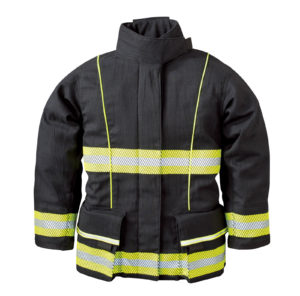
By building the best teams, improving continuously and putting the customer first—always—companies that put innovation to work keep customers coming back.
When Steve Jobs, the late CEO of Apple, introduced the iPhone in 2007, his name became synonymous with innovation—a business practice and marketing advantage that isn’t particular to any one industry. Nor is it dependent on a company’s size. Innovation may be part inspiration, but it’s probably more perspiration in reality. It works when organizations develop a strategic plan backed by the right team, a pledge to make continuous improvement an operating reality, and a willingness to take chances—as well as to demonstrate resilience should failure occur. Failure, when included in the business plan, means another opportunity.
Strength in diversity
Winner of the Industrial Fabrics Foundation (IFF) 2016 Innovation Award, Gelvenor Textiles knows that innovation can’t thrive on an island. The South African company developed a woven polyester microfiltration fabric to provide safe drinking water to rural communities without electricity or access to water treatment chemicals. The fabric removes colloidal contaminants and dangerous bacteria from water at a high flow rate. To put the product into practice, Gelvenor formed a research and development (R&D) partnership with South African water researchers to create a gravity-driven household water treatment unit.
To embrace innovative thinking throughout the entire organization, Gelvenor recently restructured its business. Sefton Fripp, innovation and marketing manager, is leading the innovation initiative and developing a strategy for encompassing three key elements: people, process and product. That strategy includes educating employees about how they contribute to innovation and understanding how innovation operates in a lean organization.
Company strategy also will re-examine how Gelvenor works with customers, perhaps the most important team member of all. “Historically we’ve engaged directly with our customer base to determine what their future or immediate needs are,” Fripp says. “Where we have fallen short is not always interpreting their needs and wants into the correct product. This is where innovation has a vital role to play by ensuring that all R&D projects are carefully planned in line with customer-specific requirements.”

of electrical cables. Photos: Lindstrand Technologies.
For the tension structures and other commercial fabric installations his company creates, Jim Miller, president of J. Miller Canvas Inc., Santa Ana, Calif., works hand in hand with architects. Miller says that having this relationship is one of the most important ways to innovate.
“Architects are architects for a reason,” he says. “They have years of training; they push the envelope of what’s possible and we get to look very creative along with them. But they really deserve the credit most of the time.”
Because J. Miller Canvas works with architects every day, using the same software they do—such as SketchUp, Awning Composer and AutoCAD—“is critical to communicating our ideas,” Miller says.
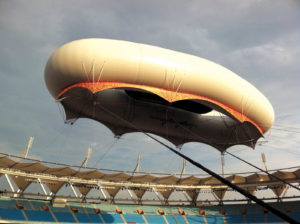
Forming close working relationships with suppliers and partners on every new project is critical to innovation, says Debra Aperfine, president of Chameleon International LLC in Greensboro, N.C. “Because of these relationships we’ve built over the past 16 years, our teams work as one in developing new innovative solutions to customer requests,” Aperfine says. “This process begins with the end in mind and will include all aspects of the process: cost, manufacturability, quality, waste and so on.”
Above all, these businesses recognize that without buy-in from staff, innovation efforts can stall or fail. Miller has found that allowing his shop employees the freedom to express their thoughts naturally creates an innovative environment. “They are, after all, the ones doing the work every day, so their ideas are always welcome,” he says.
Avoid the research rush
Companies that prioritize innovation often commit to a range of R&D activities, including customer surveys, focus groups and scientific study. As manufacturers face various pressures to get a product to market as quickly as possible, however, R&D is the last place they should cut corners.
A premature product launch led to serious consequences in 2016 when Samsung Electronics Co. recalled 2.5 million Note 7 smartphones after news surfaced of phone batteries bursting into flames. Media reports pointed to a supplier production error that went overlooked during the rushed testing process as the cause of the faulty batteries.
As it prepares to roll out a new product called the Glacier Awning, Rainier Industries, Tukwila, Wash., ruled out a hasty introduction. “We’re a relatively new player as an OEM shade supplier, and we took the time required to get this right,” says Scott Campbell, CEO. “Designing a product unlike anything else in the industry meant that we had to invest in research and development to make sure it met our high expectations.” The company won a silver award for Manufacturer of the Year from Seattle Business magazine in 2015, based on company performance, overall business strategy, manufacturing process improvements and innovations, and working relationships with customers.
According to Campbell, the idea for the Glacier Awning derived from a lack of innovation in the market. Members from Rainier’s executive, design and sales teams attended an expo in Germany several years ago, “and noticed that every awning manufacturer’s product looked roughly the same,” Campbell says.
Led by Rainier’s COO, David Traub, the team soon discussed their vision of the perfect awning arm. “It needed to be strong but quiet, and built to order to stay within our lean initiative since we don’t want to have a stockpile of inventory,” Traub says. The product also needed to have adjustable tension and be repairable in the field.
The Glacier Awning can be made in any width and projection up to 13 feet, 6 inches, and powder-coated any color—two features currently lacking in the market, according to Campbell. The awning also incorporates LED lights that can be oriented up or down, and enclosed within the arm.
Voice of the customer
Businesses often claim to put the customer first, then launch a product that over-promises or misses the mark altogether. But when your end users are firefighters, for example, mistakes are more than minor problems.
Globe Manufacturing Company LLC, Pittsfield, N.H., makes protective clothing for firefighters. “Our customers willingly respond to the wide range of emergencies that happen every day, often risking their own lives to protect us,” says Mark Mordecai, Globe’s director of business development. “And in order to do their jobs safely and well, they need the best equipment that we can develop.” The company was one of the top ten IFF award winners in 2014, recognized for its WASP™ Shirt (Wearable Advanced Sensor Platform).
Accordingly, the company has embraced the customer-first philosophy. “We ask, ‘How can we say yes to the customer?’ instead of the easier ‘We don’t do things that way,’” Mordecai says.
Globe’s product development is driven by a process known as “voice of the customer” (VOC). The company interviews a broad cross-section of end users in their environment to understand what they experience while wearing Globe’s gear and what they need to improve that experience. This methodology collects language data and distills it through a series of reviews into a map of key “wants.” “From this knowledge, we apply our experience and expertise to develop solutions, which often leads us to create all-new designs and to work with resources to create new materials and technology to enable them,” Mordecai says.
After the VOC exercise, Globe creates a design project to define its objectives, prototype and iterate potential solutions (“which often requires us to invent something,” Mordecai notes), solicit feedback from users, refine the solution and validate with end users through field trials.
VOC informed the development of ATHLETIX™ turnout gear, which won an IFAI International Achievement Award (IAA) Award of Excellence and Best in Category for Advanced Textiles in 2016. Globe collaborated with three supplier partners—TenCate Protective Fabrics, DuPont Protection Solutions and the 3M Company—to create turnout gear with stretch fabrics for a body-contoured, smoother fit that is lighter weight and offers unprecedented range of motion.
Learning from failure
When the prolific American author James Patterson was asked how he is able to write so many novels in a year, he responded, “Keep going, keep going, keep going.”
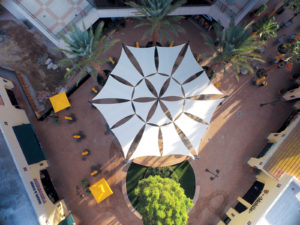
Photo: J. Miller Canvas.
The same holds true for an innovative company. It’s better to be the pacesetter than the one trying to catch up, but that journey to industry leadership will undoubtedly have bumps along the way. That means taking chances—and trying again if failure occurs.
Per Lindstrand, founder and president of Lindstrand Technologies Ltd., Oswestry, United Kingdom, has implemented his own brand of “keep going.” The aeronautical engineer became a hot air balloon manufacturer in 1978, and nine years later, designed and piloted the balloon that took him and Virgin Group founder Sir Richard Branson on a record-breaking trip across the Atlantic.
But Lindstrand experienced his share of turbulence over the years as well, including a boardroom shake-up that left him jobless in a declining balloon market. He’s now at the helm of Lindstrand Technologies, which manufactures inflatable applications ranging from aerostats to building designs.
“We have been in this business 39 years, and we know just about everything about it,” Lindstrand says. “If customers have something impossible to build, they come to us.”
This combination of experience and innovation, even in the face of adversity, has resulted in one-of-a-kind projects. Lindstrand points to the aerostat that floated above the Jawaharlal Nehru Stadium in New Delhi, India, for the 2010 Commonwealth Games. With a volume of 22,000 cubic meters, it is the biggest tethered building created to date, according to Lindstrand. The helium-filled structure, completed in only four months, comprised 11 miles of fabric.
Next up for Lindstrand Technologies is an inflatable hangar in Long Beach, Calif., for the tire manufacturer Goodyear to store its airship. Measuring 100 meters long, 40 meters wide and 26 meters tall, the hangar is expected to be one of the biggest fabric structures in the world.
With other projects under its belt such as leak-testing technology for power stations, Lindstrand Technologies expects to build upon its track record for innovation. “In the future, we will have better materials and better technology, and we will do more complex things,” Lindstrand says.
The next big thing
By nature, innovators are always looking ahead—and dreaming big. In the case of Chameleon International, a big dream literally launched the company. The daughter of Chameleon’s founder, Debra Aperfine, dreamed of a magical raincoat that changed colors. After her child enthusiastically recounted her tale the next day, Aperfine asked herself, “What if?” Five years later, in 2006, ChroMyx™, a line of temperature-sensitive, color-changing flexible material, made its first production run.
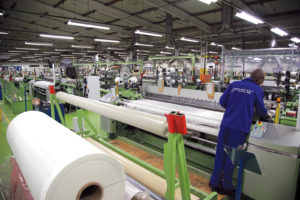
Chameleon, the inaugural winner of the IFF Innovation Award in 2010, spends a lot of time learning about customers’ current products. “We listen very carefully to their goals, incorporating our technology so we exceed their expectations,” Aperfine says.
The company evaluates current products and develops ways to create the next generation of those products for customers. “Chameleon pays close attention to trends so we can be on the cutting edge of new innovation,” Aperfine says. She is keeping a particularly close eye on the development of new smart fabrics.
Chameleon also produces film in multiple temperatures and colors for adhesive applications that can be used for industrial purposes. Aperfine foresees the technology’s use in more functional applications such as food safety monitoring, personal safety and visual indicators for early alert systems in a broad range of industries.
Many manufacturers foresee a promising future needing increasingly innovative offerings. J. Miller Canvas looks to capitalize on the booming construction business in Southern California.
“Comfortable, usable outdoor space is important here, so our shade structures in common areas of business complexes are very popular,” Jim Miller says.
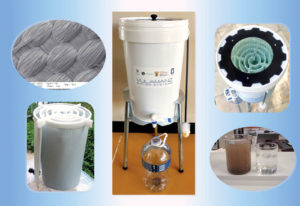 Globe Manufacturing’s Mordecai predicts that product lifecycles will continue to get shorter as new technology becomes available. He also forecasts the emergence of more modular ways for firefighters to build their protection to suit their environment, rather than having multiple types of gear for different applications or wearing a universal service garment providing maximum protection but less suitable for everyday wear.
Globe Manufacturing’s Mordecai predicts that product lifecycles will continue to get shorter as new technology becomes available. He also forecasts the emergence of more modular ways for firefighters to build their protection to suit their environment, rather than having multiple types of gear for different applications or wearing a universal service garment providing maximum protection but less suitable for everyday wear.
For long-term success, an innovative company needs to consider not only the next generation of product, but the next generation of user. “The way consumers purchase [products] evolves as technology improves and millennials become our largest buying group,” says Rainier’s Campbell. “They demand instant information and easy transactions.”
Campbell calls e-commerce a critical factor in fueling growth. “We expect to see more and more sales through online ordering in the coming years, and most of our investments are pointed toward that,” he says.
Holly O’Dell is a freelance writer and editor based in Joshua Tree, Calif.
Discussions about innovation often center around the development of new technology, materials, methods and products. But one natural fiber domesticated 5,000 years ago still holds some mystery to explore, according to Seshadri Ramkumar, Ph.D., professor of technical textiles in the department of environmental toxicology at Texas Tech University.
About 10 years ago, Ramkumar’s research on the versatility of cotton as a technical textile led to the invention of FiberTect®, a nonwoven decontamination wipe capable of cleaning toxic chemical agents.
Ramkumar continues to pursue innovative uses of cotton. During a four-year project that concluded in 2014, he and his team of researchers discovered that unprocessed raw cotton made into a nonwoven cotton batt collected up to 50 times its own weight in oil. The findings showed tremendous potential for environmental cleanup on land and in water following oil spills. Building on that research, a study in early 2017 found that finer and coarser raw cotton in loose form performs best for absorbing oil. Processed cotton, such as that used in bandages, is bleached and has the wax removed.
“When you remove the wax, the water will go into the cotton, and it will sink,” Ramkumar explains. “But when you leave the wax in, the water and oil separate. The cotton only picks up the oil and floats on the surface.”
Once the oil is squeezed out of the cotton, the material can be reused or thrown away, since it decomposes in the ground. The goal of the research is to commercialize a biodegradable alternative to the mostly synthetic-based oil remediation products currently on the market.
 TEXTILES.ORG
TEXTILES.ORG


